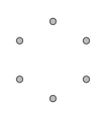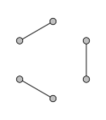Regular graph
 From HandWiki - Reading time: 4 min
From HandWiki - Reading time: 4 min
In graph theory, a regular graph is a graph where each vertex has the same number of neighbors; i.e. every vertex has the same degree or valency. A regular directed graph must also satisfy the stronger condition that the indegree and outdegree of each internal vertex are equal to each other.[1] A regular graph with vertices of degree k is called a k‑regular graph or regular graph of degree k. Also, from the handshaking lemma, a regular graph contains an even number of vertices with odd degree.
Special cases
Regular graphs of degree at most 2 are easy to classify: a 0-regular graph consists of disconnected vertices, a 1-regular graph consists of disconnected edges, and a 2-regular graph consists of a disjoint union of cycles and infinite chains.
A 3-regular graph is known as a cubic graph.
A strongly regular graph is a regular graph where every adjacent pair of vertices has the same number l of neighbors in common, and every non-adjacent pair of vertices has the same number n of neighbors in common. The smallest graphs that are regular but not strongly regular are the cycle graph and the circulant graph on 6 vertices.
The complete graph Km is strongly regular for any m.
Existence
The necessary and sufficient conditions for a [math]\displaystyle{ k }[/math] regular graph of order [math]\displaystyle{ n }[/math] to exist are that [math]\displaystyle{ n \geq k+1 }[/math] and that [math]\displaystyle{ nk }[/math] is even.
Proof: A complete graph has every pair of distinct vertices connected to each other by a unique edge. So edges are maximum in complete graph and number of edges are [math]\displaystyle{ \binom{n}{2} = \dfrac{n(n-1)}{2} }[/math] and degree here is [math]\displaystyle{ n-1 }[/math]. So [math]\displaystyle{ k=n-1,n=k+1 }[/math]. This is the minimum [math]\displaystyle{ n }[/math] for a particular [math]\displaystyle{ k }[/math]. Also note that if any regular graph has order [math]\displaystyle{ n }[/math] then number of edges are [math]\displaystyle{ \dfrac{nk}{2} }[/math] so [math]\displaystyle{ nk }[/math] has to be even. In such case it is easy to construct regular graphs by considering appropriate parameters for circulant graphs.
Properties
A theorem by Nash-Williams says that every k‑regular graph on 2k + 1 vertices has a Hamiltonian cycle.
Let A be the adjacency matrix of a graph. Then the graph is regular if and only if [math]\displaystyle{ \textbf{j}=(1, \dots ,1) }[/math] is an eigenvector of A.[2] Its eigenvalue will be the constant degree of the graph. Eigenvectors corresponding to other eigenvalues are orthogonal to [math]\displaystyle{ \textbf{j} }[/math], so for such eigenvectors [math]\displaystyle{ v=(v_1,\dots,v_n) }[/math], we have [math]\displaystyle{ \sum_{i=1}^n v_i = 0 }[/math].
A regular graph of degree k is connected if and only if the eigenvalue k has multiplicity one. The "only if" direction is a consequence of the Perron–Frobenius theorem.[2]
There is also a criterion for regular and connected graphs : a graph is connected and regular if and only if the matrix of ones J, with [math]\displaystyle{ J_{ij}=1 }[/math], is in the adjacency algebra of the graph (meaning it is a linear combination of powers of A).[3]
Let G be a k-regular graph with diameter D and eigenvalues of adjacency matrix [math]\displaystyle{ k=\lambda_0 \gt \lambda_1\geq \cdots\geq\lambda_{n-1} }[/math]. If G is not bipartite, then
- [math]\displaystyle{ D\leq \frac{\log{(n-1)}}{\log(\lambda_0/\lambda_1)}+1. }[/math][4]
Generation
Fast algorithms exist to generate, up to isomorphism, all regular graphs with a given degree and number of vertices.[5]
See also
References
- ↑ Chen, Wai-Kai (1997). Graph Theory and its Engineering Applications. World Scientific. pp. 29. ISBN 978-981-02-1859-1. https://archive.org/details/graphtheoryitsen00chen/page/29.
- ↑ 2.0 2.1 Cvetković, D. M.; Doob, M.; and Sachs, H. Spectra of Graphs: Theory and Applications, 3rd rev. enl. ed. New York: Wiley, 1998.
- ↑ Curtin, Brian (2005), "Algebraic characterizations of graph regularity conditions", Designs, Codes and Cryptography 34 (2-3): 241–248, doi:10.1007/s10623-004-4857-4.
- ↑ [1][citation needed]
- ↑ Meringer, Markus (1999). "Fast generation of regular graphs and construction of cages". Journal of Graph Theory 30 (2): 137–146. doi:10.1002/(SICI)1097-0118(199902)30:2<137::AID-JGT7>3.0.CO;2-G. http://www.mathe2.uni-bayreuth.de/markus/pdf/pub/FastGenRegGraphJGT.pdf.
External links
- Weisstein, Eric W.. "Regular Graph". http://mathworld.wolfram.com/RegularGraph.html.
- Weisstein, Eric W.. "Strongly Regular Graph". http://mathworld.wolfram.com/StronglyRegularGraph.html.
- GenReg software and data by Markus Meringer.
- Nash-Williams, Crispin (1969), Valency Sequences which force graphs to have Hamiltonian Circuits, University of Waterloo Research Report, Waterloo, Ontario: University of Waterloo
 |
 KSF
KSF



